 O Rio Grande do Sul vive uma tragédia sem precedentes, em parte decorrente das mudanças climáticas e, em parte, decorrente das ações e omissões de governos e pessoas na legislação ambiental (como por exemplo, a permissão de construções praticamente dentro de áreas de inundação e rios). Essa situação é dramática e sublinha a importância da comunicação em situações de crise e, particularmente, da gestão desses processos em plataformas de mídia social. Foi necessário, em muitos casos, fazer com que informações e pedidos de evacuação chegassem com urgência para certas parcelas da população em algumas localidades. Em outras, foi preciso pedir atenção. Ainda em outras, concentraram-se esforços em encontrar pessoas presas em suas casas e solicitar socorro. Porém, toda essa situação também sublinhou a falta de planejamento e preparo para o fenômeno da desinformação na crise. Faço aqui um breve texto com considerações sobre essa questão.
O Rio Grande do Sul vive uma tragédia sem precedentes, em parte decorrente das mudanças climáticas e, em parte, decorrente das ações e omissões de governos e pessoas na legislação ambiental (como por exemplo, a permissão de construções praticamente dentro de áreas de inundação e rios). Essa situação é dramática e sublinha a importância da comunicação em situações de crise e, particularmente, da gestão desses processos em plataformas de mídia social. Foi necessário, em muitos casos, fazer com que informações e pedidos de evacuação chegassem com urgência para certas parcelas da população em algumas localidades. Em outras, foi preciso pedir atenção. Ainda em outras, concentraram-se esforços em encontrar pessoas presas em suas casas e solicitar socorro. Porém, toda essa situação também sublinhou a falta de planejamento e preparo para o fenômeno da desinformação na crise. Faço aqui um breve texto com considerações sobre essa questão.
A desinformação nessa crise parece atuar em dois níveis. O primeiro, mais contextual, trouxe conteúdos falsos e enganosos que buscaram tentar desacreditar e culpabilizar autoridades políticas, seja pela imputação de ações, quanto omissões que implicam que essas autoridades estavam diretamente atuando para piorar a tragédia (vide exemplos a seguir, retirados de checagens).
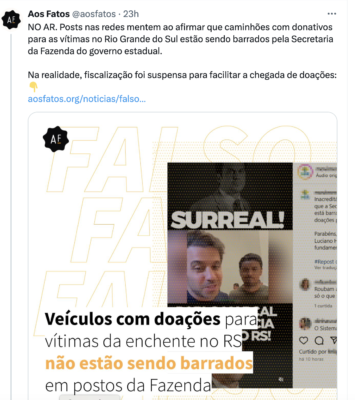
Figura 1: Imagem do Twitter.
Na figura acima (Figura 1) vemos uma checagem da agência Aos Fatos apontando que a Fazenda estadual não estava barrando veículos com auxílios para as vítimas das enchentes.

Figura 2: Imagem do Twitter.
Na figura acima (Figura 2), a agência Lupa desmente que o presidente Lula tenha patrocinado o show de Madonna no Rio e não tenha enviado recursos aos atingidos no RS.
Essa desinformação, quase sempre de natureza política, atinge e percepção coletiva da tragédia, instrumentalizando-a para atingir autoridades políticas e ações políticas.
Também vimos um segundo tipo de desinformação, mais pontual e específica. Esta acompanhou notícias e fatos em localidades específicas e circulou de modo a gerar alarme, horror e mais pânico junto a população. Esse tipo de conteúdo, por exemplo, imitou conteúdo oficial indicando áreas de risco (porém com áreas diferentes marcadas), trouxe pânico ao afirmar em regiões não atingidas pelas cheias que haveria desabastecimento de comida, relatos falsos de corpos boiando e etc. Quase sempre com tons conspiratórios (“saiba o que ninguém quer que você saiba”) , esses conteúdos minam a confiança nas autoridades públicas, confundem a população e pioram a situação.
A figura a seguir, (Figura 3) outro exemplo, desmente a informação de que teríamos 300 corpos encontrados em uma das cidades atingidas.
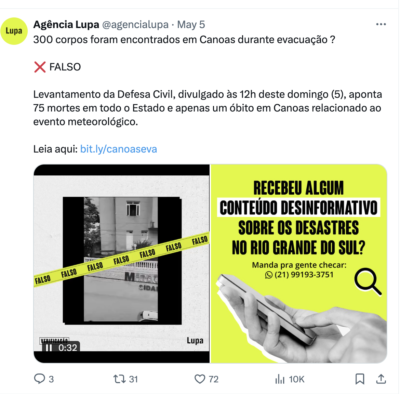
Figura 3: Imagem do Twitter.
Na imagem a seguir (Figura 4), um jornal explicita que não havia “desabastecimento generalizado” de gasolina, o que tinha levado muitos a uma corrida aos postos para abastecer (e gerando, assim, pela altíssima demanda, desabastecimento).
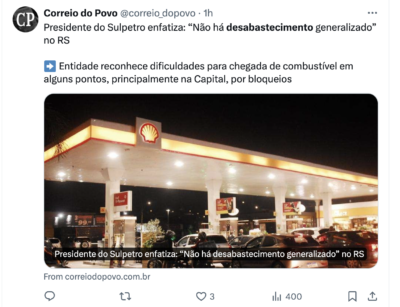
Figura 4: Imagem do Twitter.
Esses dois tipos de desinformação, contextual e específica, geram tipos diferentes de efeitos na população. No primeiro caso, a desinformação gera descrédito da população nas autoridades (principalmente governamentais, mas também, científicas, por exemplo). No segundo, dificultam a chegada de informação relevante e urgente, amplificam os problemas e afetam, diretamente, a tomada de decisões ruins pelas pessoas. Enquanto o primeiro caso foca o confirmation bias, o famoso “viés de confirmação”, extremizando posições políticas, o segundo foca o pânico, o medo, e o sentimento de desespero.
Como esses conteúdos problemáticos circulam com força e rapidez pelas plataformas mais fechada de mídia social, como os mensageiros (WhatsApp e Telegram, por exemplo) é mais difícil que sejam rapidamente desmentidos, pois demoram até chegar às autoridades. Eles se aproveitam das mesmas vias que as pessoas utilizam para se informar em ocasiões como esta, gerando visibilidade e credibilidade para esses conteúdos, pois circulam dentro de grupos e canais onde há o objetivo de informar-se e obter conteúdos relevantes. Eles monetizam a tragédia. E as consequência são gravíssimas.
Obviamente que a desinformação na crise é um problema de governança das plataformas. Embora a desinformação tenha existido sempre, são essas infraestruturas que lhe conferem capacidade de monetizar, ganhar audiência e visibilidade. Porém, é também um problema que precisa ser enfrentado na comunicação de crise. É preciso, assim, também pensar a comunicação de crise com a desinformação nas plataformas em vista.
E o que podemos fazer para combater a desinformação nesses momentos? Faço algumas sugestões:
- Ter canais oficiais de conteúdo institucional nessas plataformas, e usar esses canais de modo a não permitir que se tenha um vácuo informacional que possa ser preenchido por desinformação.
- Monitorar para atuar rapidamente no espalhamento de desinformação ESPECIFICA, que pode trazer consequências piores no curto prazo. Esse tipo de desinformação precisa ser prioritária em crises como a nossa, pois gera caos imediato e piora a situação de modo geral, inclusive, colocando as pessoas em risco.
- Atuar de no combate sistêmico à desinformação CONTEXTUAL, principalmente através do apoio a um ecossistema de combate à desinformação, com a atuação de agências de checagem e veículos jornalísticos. Embora esse tipo de desinformação seja igualmente importante, ela não tem efeitos imediatos, mas é o seu acúmulo que gera descrédito.
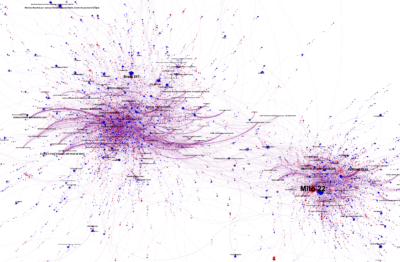 Overview of results:
Overview of results: 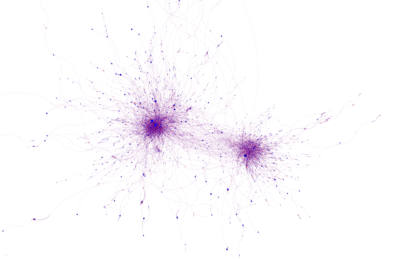
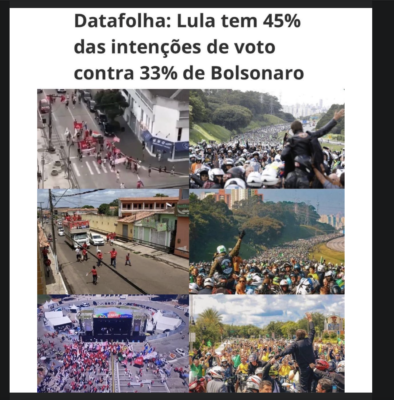
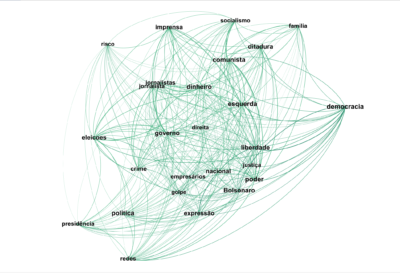
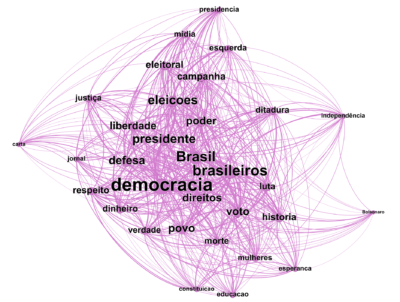
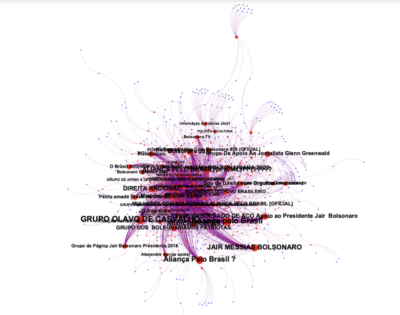 Our research lab has another paper out! “
Our research lab has another paper out! “